
Helium 10 Search Volume Exposed?


Table of Contents
- Why Should We Care About Search Volume?
- Helium 10 Search Volume with Walmart.com
- Helium 10 Search Volume With Amazon
- How do you verify is Helium 10 is even in the ballpark?
- New Amazon Data Points And The Role Of Helium 10
- Product Opportunity Explorer
- A Note On Conversion Share - Within Product Opportunity Explorer
- Trends Tab - Within Product Opportunity Explorer
- How do I use this search volume?
- Search Query Performance
- Helium 10 Data Comparison
- Nothing Is Ever Perfect
- Focus on Prioritizing
- Who To Trust
What’s the difference between search volume in Helium 10 compared to the Amazon Product Opportunity Explorer search volume? And what about the Amazon Search Query Performance volume? We’re diving into all of this (and much more) so that you know exactly what you can trust to help grow your FBA business.
To listen to the full podcast, click here!
Why Should We Care About Search Volume?
Search volume. It’s something you’ll hear a lot about in the e-commerce world and rightfully so. It’s one of the most relevant metrics to anyone doing product or keyword research.
How many people every month are searching for a specific phrase associated with your product?
Why is this even important in the first place? For your product, on any platform, you only have a finite amount of real estate to use keywords. As much as we’d like to, we can’t just enter the entire dictionary of relevant keywords on our listing. How do you prioritize which keywords to use?
We must prioritize our keywords so we know which to focus on and which we may be able to leave out.
Our goal is to have the Amazon algorithm (or the Walmart algorithm) know our listing is associated with these keywords so when shoppers search for them, we show up!
The way we will tune and prioritize our Amazon SEO (search engine optimization) is through, you guessed it, search volume.
The more a keyword is being searched, the more sales it will theoretically give your product.
Helium 10 Search Volume with Walmart.com
Now, let’s talk about the history of search volume as it relates to Helium 10 tools. First, let’s talk about Walmart.com. Helium 10 is able to get the most accurate estimated search volume on Walmart.com in the game. Most tools out there are only able to show a “scale” of search volume. Before, we showed it as “high, very high, low, very low.” However now, we are able to pull a highly accurate estimated number of monthly searches for activity on Walmart.com so that you can truly make sure you are targeting the right keywords.
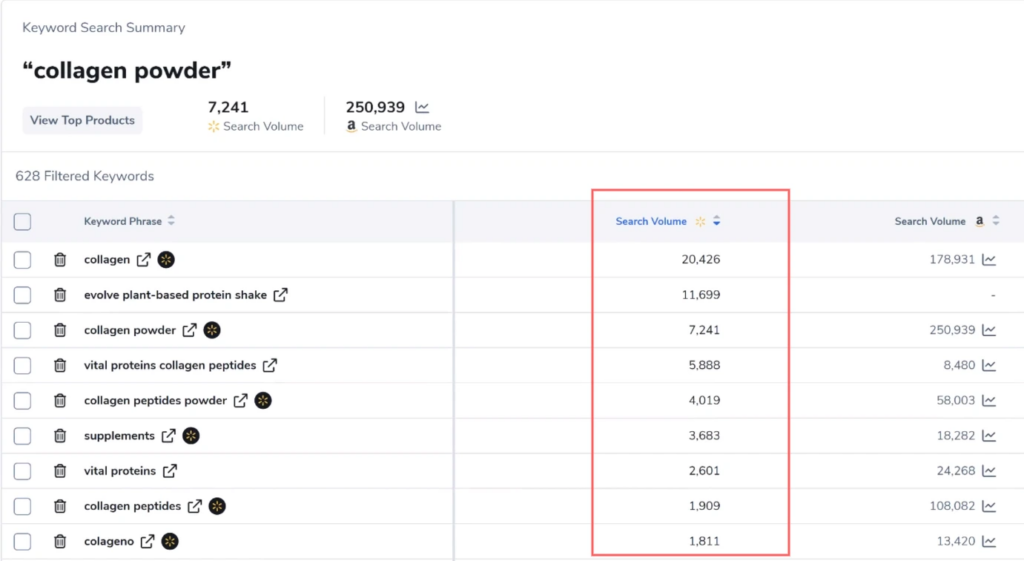
It’s important to note that you do not treat Walmart search volume and Amazon search volume the same.
For example, the keyword “collagen” has 20,000 searches on Walmart. On Amazon, we see an estimated volume of 180,000.
Speaking of Amazon…
Helium 10 Search Volume With Amazon
Amazon has a bit of a colored history when it comes to search volume. Back when I first started at Helium 10, circa 2018, we were gathering search volume directly from Amazon. Similar to what I just explained for Walmart. Although Helium 10 started gathering this information before anyone else in the FBA seller tool industry, eventually many different companies adopted this feature. Now, this was a unique data point – one that wasn’t on the front end of Amazon. So there wasn’t much documentation seeing exactly what this search volume number meant.
What we gathered from the documentation was that it illustrated a 30-day velocity, a number subject to change week to week. We noticed taking it week-by-week and adding it up, we could glimpse into the search volume for the whole month. Think of it as monthly velocity, but recalculated every week.
Most of the FBA tools available all essentially tapped into that same data point in order to display useful information for sellers. It was very helpful for prioritization.
Then one day in 2018, Amazon closed it off.
However, our data scientists were able to adapt and develop an algorithm based on what we had learned from the historical data Amazon previously made available. This, in combination with other new data points Amazon had made available, allowed Helium 10 to continue supplying sellers with estimations on monthly search volume.
This was never meant to be something claiming, “Hey, these are the exact searches in the last 30 days.” It’s an estimation.
The way that our algorithm is calculating estimations is similar to the way that Amazon seemingly used to do it.
We’re taking velocity from the most recent week, and projecting that out to form a monthly estimation. In other words, “This is what the 30-day estimated search volume is based on the most recent activity we have detected on that keyword.”
How do you verify is Helium 10 is even in the ballpark?
A handful of years ago, Amazon released something called Brand Analytics. This provided sellers with a way to see the top 1 or 2 million most searched terms for the previous week, day, month, or even quarter.
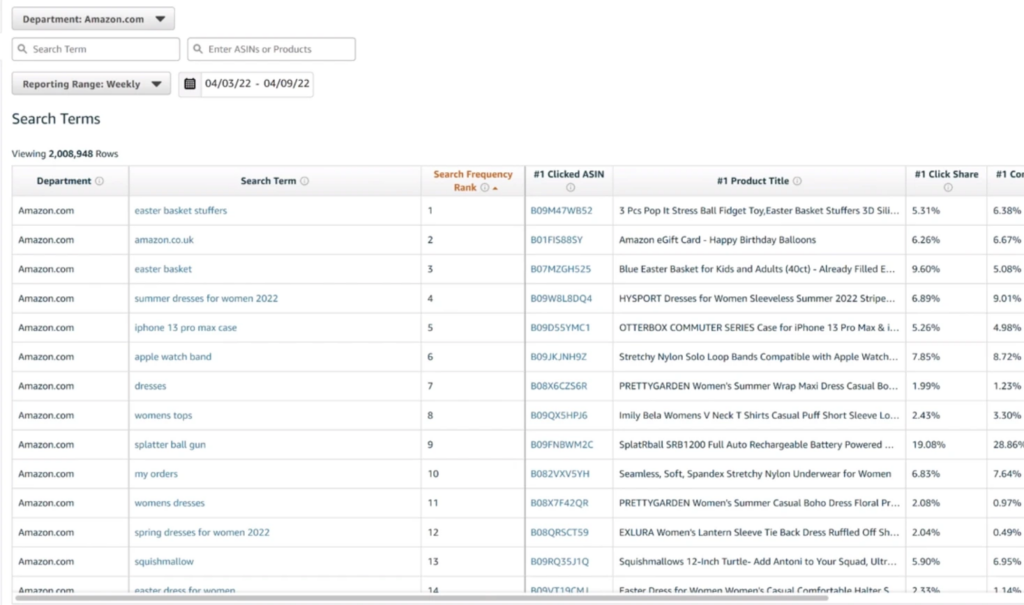
Here, I’m looking at a recent one from the week of 4/3 to 4/9. The most searched keyword, according to Brand Analytics on Amazon, was “Easter basket stuffers.”
Keep in mind, if you were to compare week-by-week search volume on Helium 10, it’s not going to 100% line up with Amazon’s Brand Analytics numbers. However, our search volume estimations align as closely as possible without actually having access to Amazon’s “under the hood” raw data.
Amazon’s Brand Analytics is the best way you can confirm that Helium 10 is in the ballpark with search volume estimations.
A word of advice. Don’t get caught up comparing various FBA tool suites to each other. What matters most is: how do these tool suite’s numbers compare to Amazon’s.
Currently, Brand Analytics is the best way you can verify actual data.
New Amazon Data Points And The Role Of Helium 10
For the last year or so Helium 10’s has staked its claim as the undisputed number one data suite out there for e-commerce sellers.
But now all of a sudden in the last few months, Amazon is releasing more data points.
More Amazon analytics is a great thing for Helium 10 and our users!
More data = more accurate tools = more success for sellers
I usually don’t like making predictions, but I almost guarantee you’re going to start seeing more doubt on social media and message boards. People saying, “Oh, wait a minute, Helium 10 search volume is so different than Amazon – what’s going on?”
So let’s start talking about some of these new data points within Amazon.
Product Opportunity Explorer
The very first one is the Product Opportunity Explorer.
Now, the Product Opportunity Explorer was launched a little while back and it doesn’t have every single keyword on Amazon included. While it isn’t as expansive as Brand Analytics, you can still see thousands of keywords in this tool.
So I type in “coffin shelf” and some interesting information comes up here. It tells me about the niche.
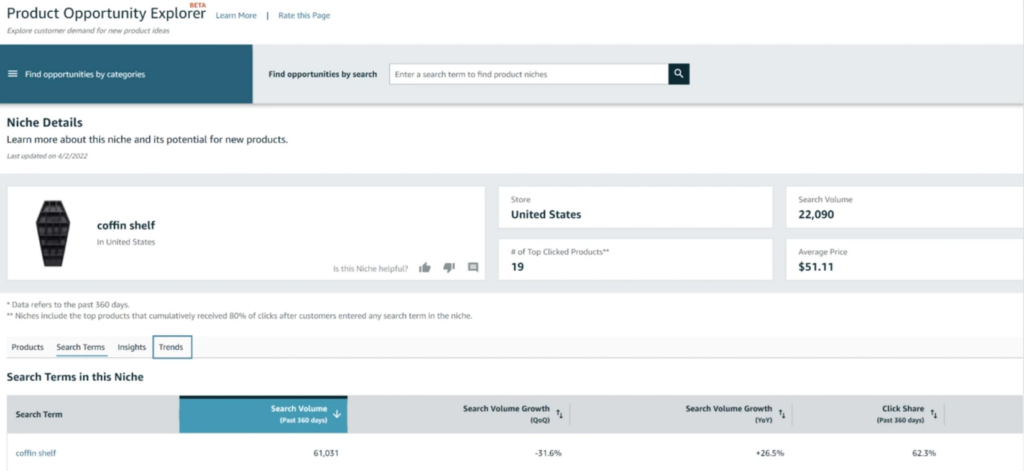
It’s showing me this has a 22,090 search volume. Now, this can be confusing. This does not mean the phrase “coffin shelf” has 22,090 total search volume. This represents 22,090 search volume, the search volume in the last 90 days of all of the keywords that Amazon says are part of this niche. Keep that in mind.
Clicking on the “search terms” tab, we can view keywords on an individual level.
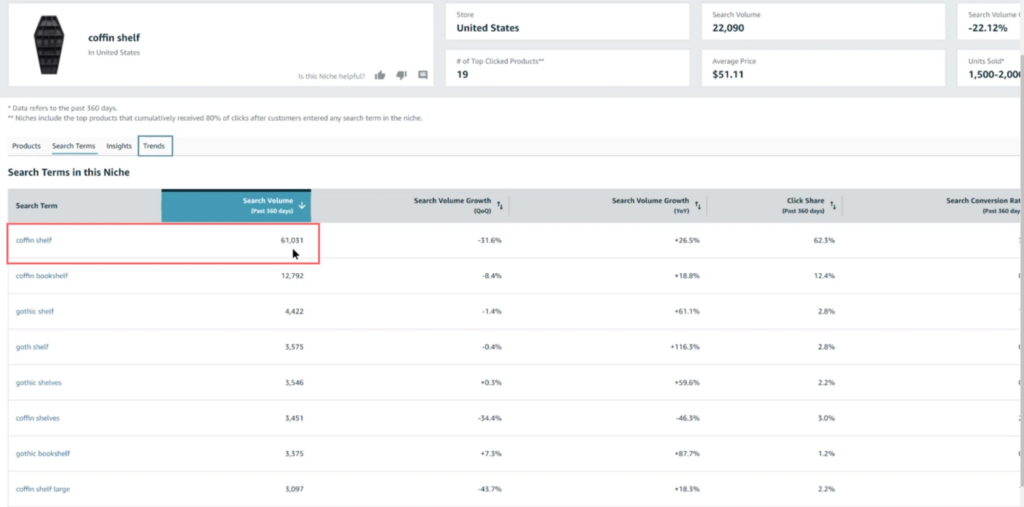
The keyword “coffin shelf” displays search volume for the past 360 days as right around 61,000 searches.
The Amazon documentation on this is not very exact – this is gonna be an ongoing theme.
Now, this is a common mistake that some people make when looking at Helium 10’s week-by-week search volume.
Remember, in Helium 10, you can click on any keyword to view the search volume history, going back a year or two. What we are estimating is the monthly search volume.
It’s a misconception that you just add that up and arrive at a full year’s worth of accurate search volume. Again, Helium 10 calculates monthly search volume on that velocity basis I explained earlier.
A Note On Conversion Share – Within Product Opportunity Explorer
Let’s take a look at conversion share. There are weird disconnects that you have to be aware of. Amazon, is for the most part, trustworthy when it comes to data, but we may not want to be taking everything completely as gospel, especially if we are not fully sure what the dataset is based on.
For example, let’s take a look back at another keyword in this niche, very similar to “coffin bookshelf,” – “gothic bookshelf.” It says in the last year, there were over 3,000 searches for this term, according to Product Opportunity Explorer. But, it says the search conversion rate of a year is 0.0%.
What does that mean?
That means that according to Product Opportunity Explorer, out of all those 3,300 searches, not one person in the last year purchased a product after searching “gothic bookshelf.”
This can’t be true. I know we converted for this keyword with our own product!
I decided to revisit Brand Analytics for October of last year. I remember that’s when there were some products that were selling for this keyword. Sure enough, I found the search term, “gothic bookshelf,” and saw the product here has 100% of the conversions.

And what does that conversion mean? That means somebody searched for this keyword and they converted for it (made a purchase!)
Let’s give Amazon the benefit of the doubt, but just keep in mind that you can’t take everything as 100% black and white. There are going to be some head-scratchers here. So just be a little bit careful when you’re looking at this data.
Trends Tab – Within Product Opportunity Explorer
One of the newest features of Product Opportunity Explorer is located within the “Trends” tab.
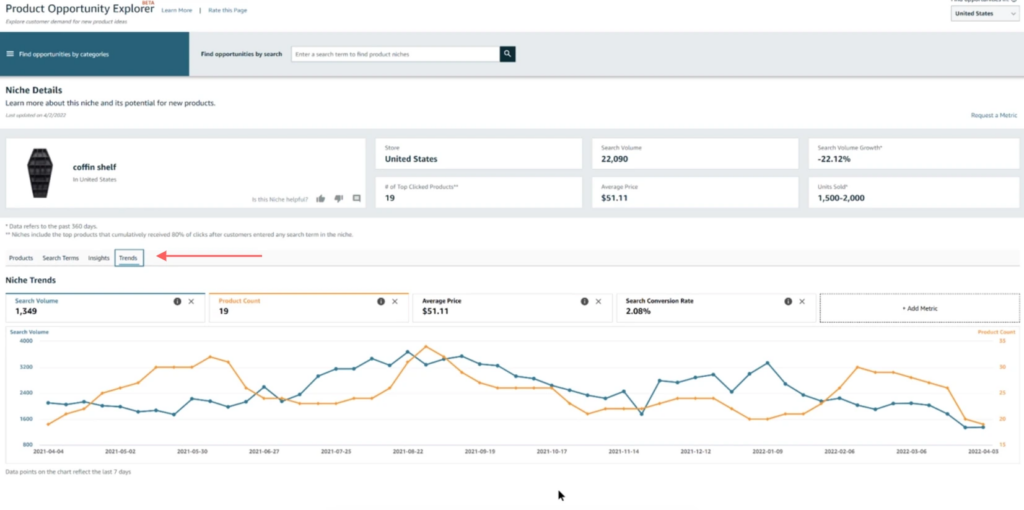
This shows you complete niche trends – the product count and the search volume of all keywords. Now, remember what the Product Opportunity Explorer says here for the total 90-day search volume of all keywords in this niche: 22,090. Hovering over the line graph allows you to view the exact search volume week by week. Adding each of these weeks’ totals up, you will notice that your total differs from what it is telling us at the top! Adding up every week, by the time we get back to mid-January, we have already surpassed what Amazon is telling us the total is, despite not being to close the 90 days!
This is just another example of why you should keep your eyes peeled when looking through numbers, even numbers provided by Amazon. Some of these tools are great for discovering general trends but might have aspects that make it seem like it contradicts themselves. This does not make this feature in Amazon useless. These differences in numbers are relatively small, and probably would not change your decision-making process.
How do I use this search volume?
I don’t typically use it for my prioritization. Why not? This is 360-day search form for these individual keywords. For example, I might discover that the keyword “halloween decor” has a search volume of 1 million for the past 360 days.
But if I’m optimizing my listing right now, and it’s April, would that be the most searched keyword for this niche? No, the more universal, non-seasonal phrases are going to be the main keywords.
In short, an entire year’s worth of search volume is not very helpful for me if I am trying to optimize my listing for right now.
When you’re optimizing your listings, do not simply compare Helium 10 with Product Opportunity Explorer. Use either Helium 10 or Brand Analytics, so you can break those searches down week by week or even day by day, if you wanted to.
Search Query Performance
Let’s talk about the new kid on the block. It’s the Search Query Performance. This is found within Brand Analytics and provides a way for visibility into your search term’s performance based on shopper search behavior for a selected timeframe. It shows you the metrics of top terms of your catalog, such as search displays, clicks, adds to shopping cart, purchases, and more. Keep in mind, this is for Brand Registered sellers only.
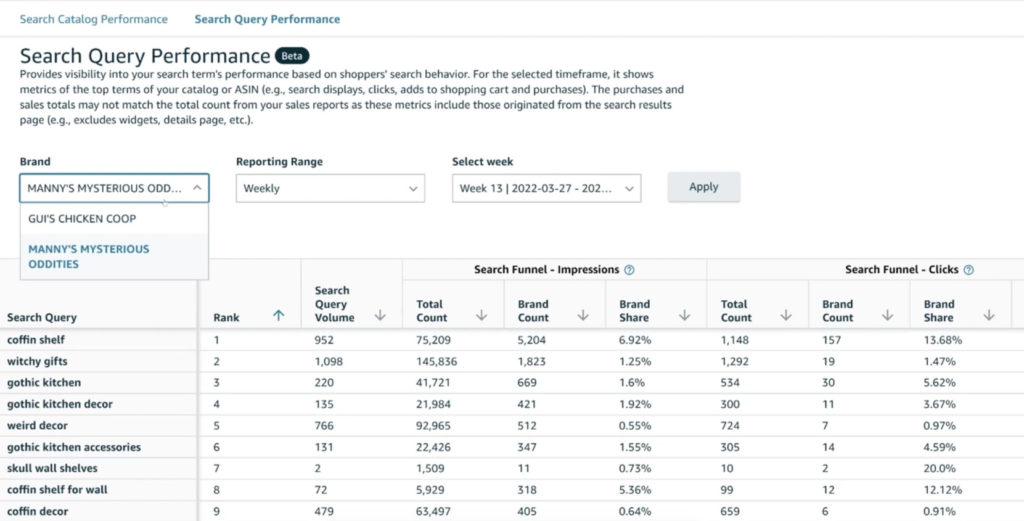
The Search Query Performance section gives you the top 1,000 search queries related to your brand. If you have 10 products in this brand, it’s related to those 10 products. If you only have one product in this brand, it’s only going to be related to that one product. You have visibility in weekly, monthly, or quarterly timeframes.
I’d like to highlight the search funnel purchases metric. In other words, after these searches, how many people actually ended up buying a product from that search? On top of that, how many did your brand account for? This is an example of an extremely powerful data point in the Search Query Performance tab.
Be aware, this is yet another place where you might see some people saying, “Hey, Bradley, this is now week to week, and I can actually compare it. I’m adding stuff up and it doesn’t match up to Helium 10!”
Again, this is apples and oranges. Completely different than the search velocity Helium 10 uses.
Helium 10 Data Comparison
Let’s just dive into this and just take an example of one of the most common keywords here, “coffin shelf.” The point here is not to directly compare Helium 10 to the Search Query Performance, but to ask… “Is Helium 10 still useful? Can you trust it?”
Let’s jump into the data.
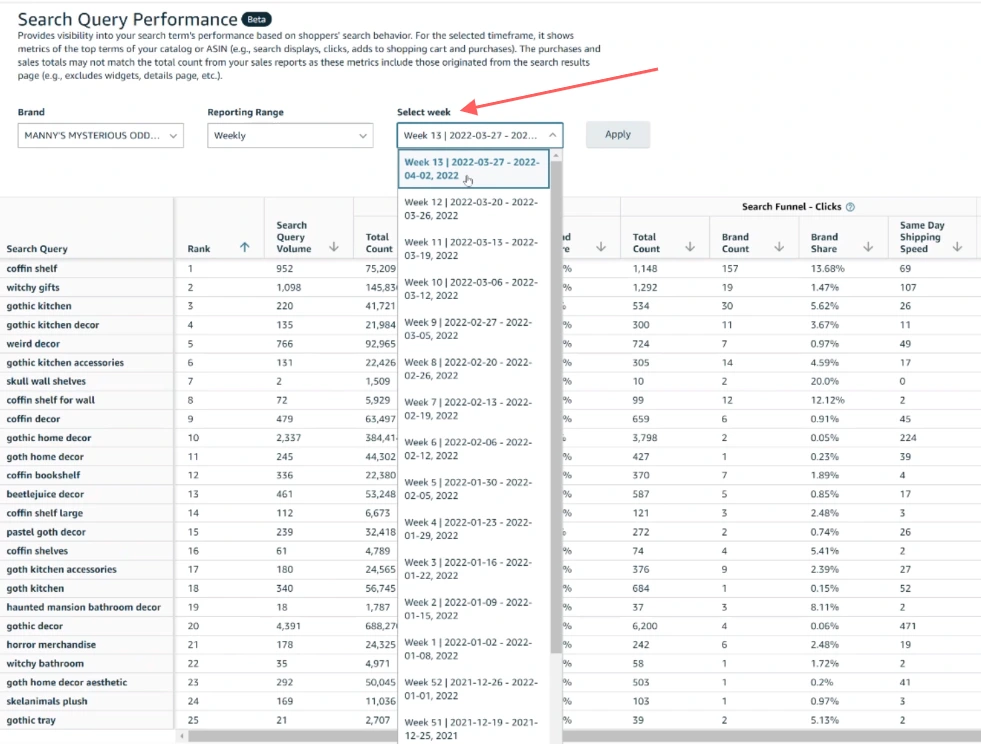
This is the last few weeks of search volume for “coffin shelf.”
- Week of 3/27 to 4/2 – 952 searches
- Week of 3/20-3/26 – 984
- Week of 3/13 to 3/19 – 955 searches
- Week of 3/6 to 3/12 – Searches jump up 1,230
Now let’s go to Helium 10 and look at the history of “coffin shelf.” Again, the number is not going to be the same.
As of 4/2, Helium 10 is showing 5,396.
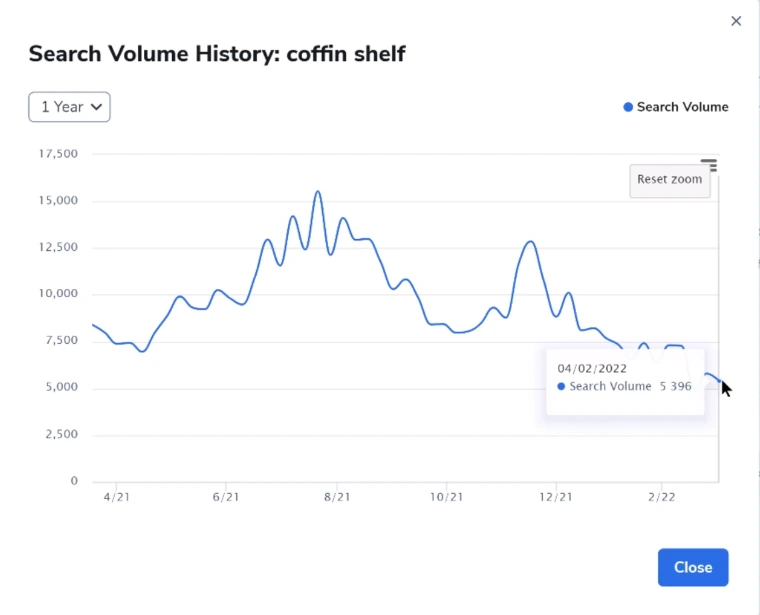
This doesn’t mean that Helium 10 is multiplying search volume by five! Again, this number is the monthly estimated search volume base on velocity.
Hovering over the same weeks we mentioned above, within the Helium 10 graph shows us the same relative pattern. Even going all the way back to the week of 3/6-3/12 where we noticed that spike.
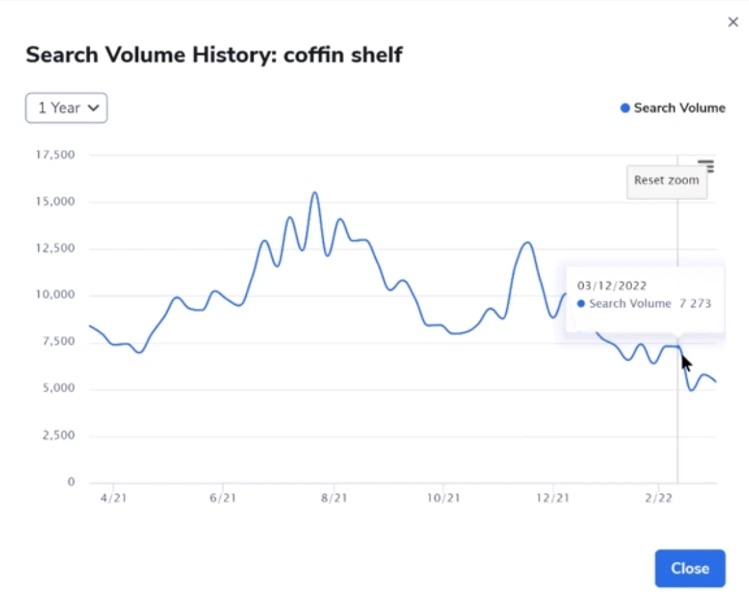
According to Helium 10, the velocity of search volume almost perfectly matches up to the actual search volume Amazon is reporting. Will it always be spot on the nose? Not to the digit, no. The point is that Helium 10 must be getting the right data points because, completely independent of this Search Query Performance being released (which we didn’t have access to because it just came out), Helium 10 was still able to detect the correct peaks and valleys of search volume.
Nothing Is Ever Perfect
Just because we can, let’s take a look at some of the same keywords and how three different tools measure their search volume – The Product Opportunity Explorer and Brand Analytics (both from Amazon) along with Magnet by Helium 10. This comparison is all for the same week of 3/27-4/2.
Product Opportunity Explorer (via Search Query Performance)
“gothic” – 2,458 search query volume
“gothic home decor” – 2,337 search query volume
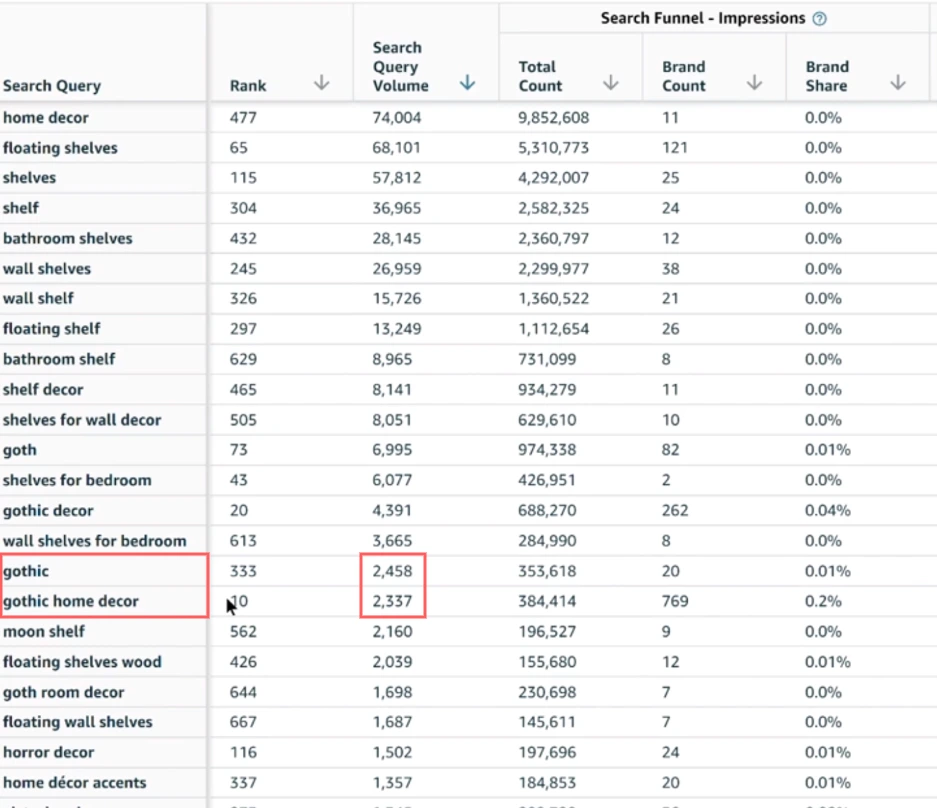
Brand Analytics
“gothic” – 32,136 search frequency rank
“gothic home decor” – 23,123 search frequency rank
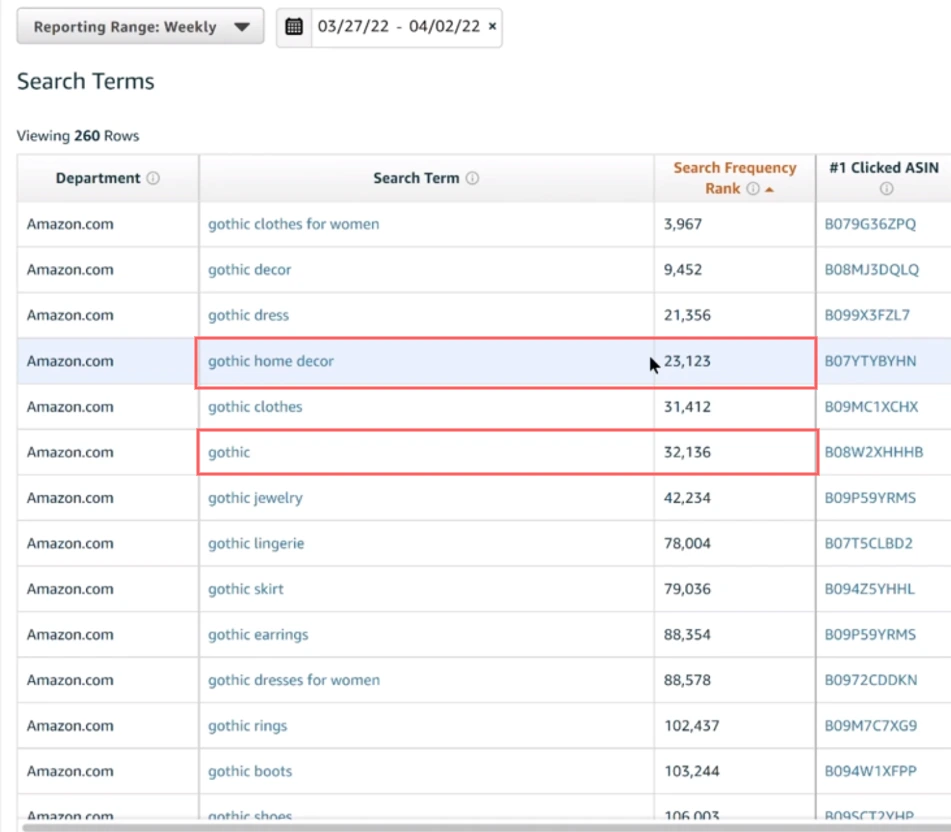
Not only are these different numbers, but a complete flip-flop in terms of which phrase is being searched more! This doesn’t mean the data is bad, it simply illustrates the existence of apparent differences within Amazon’s own tools.
Helium 10 – Magnet
“gothic” – 12, 192 search volume
“gothic home decor” – 17,299 search volume
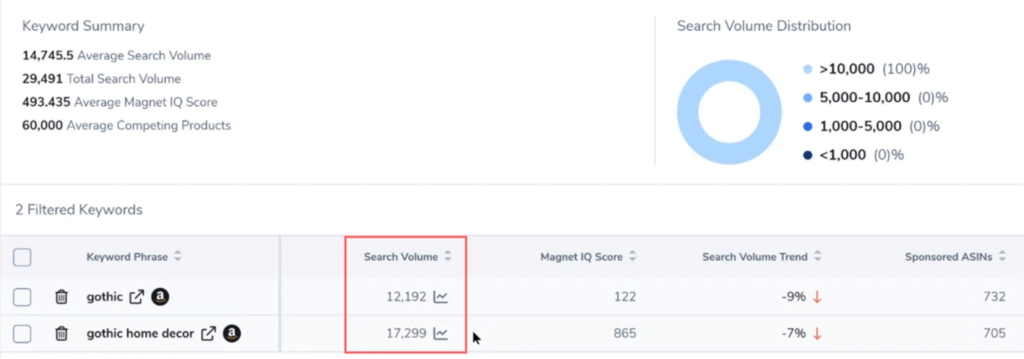
In this case, Helium 10 veers closer to Brand Analytics.
We’ve got three different tools here, two from Amazon, and one from Helium 10, all showing somewhat different information. Is a discrepancy of 12,000 to 17,000 searches going to break your business? No.
You have multiple data points at your disposal. Use them all but always keep in mind there will always be discrepancies.
Focus on Prioritizing
So what was the point of this?
Search volume for Walmart.com and Amazon.com is critical to know. Why? It helps you prioritize your keywords.
Remember, when it comes to keywords what’s most important is relevancy. Search volume for a keyword is not going to matter if the keyword is not relevant to your product. You can’t just look at a keyword and say, “Hey, what’s the magic search volume number I need to win?”
You’re gonna find keywords that have different stages of relevancy; Tier one, Tier two, Tier three, etc.
Within each of those tiers, you must prioritize what you’re gonna focus on. Be it for PPC, for your listing optimization, or other targeting campaigns off-Amazon. Whatever the case is, you must be able to prioritize.
Who To Trust
There are a lot of different sources nowadays for search volume, both within Helium 10 and elsewhere.
For Walmart? It’s easy. You got one source, directly from Helium 10. Since you can’t view the data directly from Walmart, Helium 10 is your only source for this important metric!
For Amazon? It’s a different story – you have options. Take advantage of them all, just remember it isn’t always apples to apples.
So you might want to pick and choose which one you’re gonna use for different cases.
I love looking at Product Opportunity Explorer to try and find that search conversion share and to see what Amazon considers a niche.
I like this new Amazon Search Query function that has all these other data points that Amazon has never historically shown.
At the end of the day, if I’m trying to optimize my listing, I still use Helium 10 search volume.
Brand Analytics unfortunately doesn’t divide things into niches, or buckets of keywords like Helium 10. The Product Opportunity Explorer does, but also has a very limited number of searches.
Search volume consistency and the ability to prioritize still make Helium 10 an invaluable tool for your business.
Achieve More Results in Less Time
Accelerate the Growth of Your Business, Brand or Agency
Maximize your results and drive success faster with Helium 10’s full suite of Amazon and Walmart solutions.

